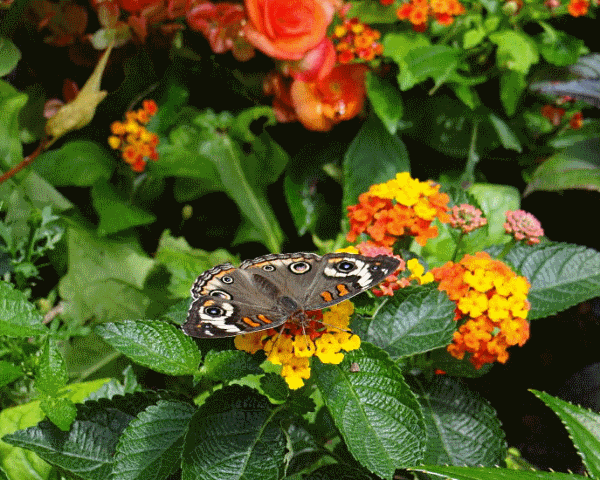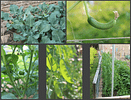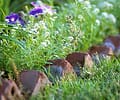When you grow a butterfly and hummingbird garden, it’s like growing a Disney movie. As the weather warms and the sweet flowers bloom, perfuming the air with their rich fragrance, butterflies will cover the area, dancing in the breezes and landing on the flowers and on you. It’s absolutely magical.
While it may take a few years for the hummingbirds to find your new garden, the first sight of a flashing green and ruby flying acrobat will thrill you to your toes – you’ll never forget that moment in your garden. As hummers feel more comfortable with you, they show no fear, flying very close, even zooming in to seemingly get a good look at your face. My hammock swings in a cluster of purple bergamot and the hummers feed there right as I relax; I could reach out and touch them, but only if I want to ruin the moment!
Attracting these Jewels
Let’s chat about how we can attract these jewels, from monarchs to buckeyes to sulphurs to those hummingbirds. Remember – don’t plant until your soil is dry enough to resemble moist coffee grounds, and a clod crumbles easily between your fingers. Planting when the soil is clumpy and wet will compress out the necessary air pockets and choke your plants.
This garden must be in full sun, 6-8 hours worth of straight sunshine each day, as these plants need all the sunshine they can get to bloom properly. The exception is columbine, Aquilegia, which does equally well in sun and shade and is an early stop for hummingbirds.
Planting Tips
First, we must consider the mature height of the plants. If you’re planting next to your house, place the tallest plants in the back, the mid-height plants in the middle and the short plants in the front. If you’re planting an island in the middle of your lawn, plant in concentric rings, like a bullseye, with the tallest plants in the very center, the mid-height plants in the middle ring and the short plants in the outer ring, along the edge.
When your garden sits against a house or other structure, you can erect a sturdy trellis and plant a trumpet vine, Campsis, that will climb vigorously and bloom out in orange trumpet-shaped flowers, perfect for our hummingbirds. It may take a few years to get prolific bloom; in fall, trumpet vine must be cut back to the main branch every year to improve bloom and control growth.
Getting to Know the Plants
On the ground, start with Butterfly Bush, Buddleia, as your tallest plant and as a centerpiece within this garden. I recommend White Profusion as hummers and butterflies absolutely flock to it, but Black Knight is also dramatic and effective. If this bush decides it likes its spot, it can grow over 7′ tall and 6 feet wide, so be prepared! Each fall, you’ll prune this back down to the ground, as butterfly bush blooms only on new wood.
Next up is perhaps the most vitally important plant in our garden, milkweed. Milkweed is the only (read that again – ONLY) plant that Monarch butterflies lay their eggs on. It is the only (read that again – ONLY) plant that Monarch caterpillars eat. When you plant milkweed in your garden, you are helping a butterfly now in serious decline. PLANT A LOT. Common milkweed, Asclepias syriaca, grows to about 6′ and creates the most intricate pink flowers that will send out spears and curl into themselves, resulting in huge seed pods that will give your garden winter interest (and feed the birds). Butterfly milkweed, Asclepias tuberosa, is a shorter plant for your second tier and blooms orange.
Wild bergamot, Monarda fistulosa is a purple “crazy haired flower” growing to 5′ that seeds vigorously, so you’ll be able to give some to your neighbors in just a year or two.
Gayfeather, Liatris, is a purple spike of flowers about 36″ tall.
Plant purple coneflower, Echinacea purpurea, which grows to about 30″. The seed heads for these flowers will also provide food throughout the winter for purple finches and goldfinches. Plant them so they are visible through a window, as you will enjoy watching these little guys rip apart the heads in the snow.
Butterfly Blue Pincushion, Scabiosa columbaria, is about 12″ tall and will bloom again and again with attentive deadheading. Oregano and Moonbeam Coreopis round out our short perennials, with pink and yellow flowers respectively.
Annuals are also important in our butterfly and hummingbird garden. Plant parsley, as this serves as food for many larvae – and also as an herb for you!
Dwarf Zinnias, Zinnia elegans, are about 12″ tall. I prefer (and somehow think my visitors do too) the Cherry Profusion variety.
Plant Sweet Alyssum, Lobularia maritime, in the very front of your beds. At about 4″ tall, alyssum is sweet smelling, available in whites, pinks and purples and tends to droop unhappily in very hot weather. Keep them well watered.
The Key to a Successful Butterfly Garden
Here’s the key to a successful butterfly garden; plant in patches and swathes. Think of how these animals feed, fluttering and zooming along. Plant multiple plants of the same kind together, in large patches or in meandering rows. Dotting plants here and there within your bed will make feeding more difficult and your guests will consider you a meager hostess – and may not return.
Consider making a trip to a working nursery where plants are grown from seed instead of a big box store. The farther drive is worth it in a lower price, much better quality and vastly more extensive variety.
After planting, make sure you are watering well and thoroughly, at least an inch each week. Perennials need to get well established to produce for years and annuals have just one season’s chance at growth and bloom. A lightly diluted fertilizer applied weekly can help give everyone a boost.
The Arrival of Your Guests
As the weather warms, your guests will start to arrive. I suggest purchasing Peterson’s First Guides: Butterflies and Moths. This full color guide is a very handy reference to identify everyone who visits. You may realize that the butterfly you’ve seen every day is rare in your part of the country – or that the butterfly you’ve been thinking is a Monarch is actually one of its imposters!
Butterflies will trickle in and then seemingly inundate your garden, like a multi-colored snowfall in the summer. Certain species you’ll only see in the spring, and they will be replaced by other species that you may only see for a few weeks. The height of your hummingbird season may vary due to migration paths.
As you walk along the edge of your garden bed, butterflies and hummingbirds zooming, fluttering and breezing along, you may begin to see yourself as a princess – in your very own Disney movie!
About the Author
Rebecca Palumbo is a certified Master Gardener and her yard is a Certified Wildlife Habitat. Since she could hold a trowel, she has been gardening – first as her mother’s oft-reluctant assistant (read: Weed Puller) and now for her own joy. She has fought Creeping Charlie tooth and nail, struggled to grow zucchini in complete shade and continues the battle of wits, hot pepper and fencing with Damn Rabbits. She is a member of the Garden Writers Association and is the Creative Director/Founder of Rollins Palumbo Creative, a graphic design and marketing firm in Chicagoland.
Image Credit: Tinker Bell’s Butterfly House


